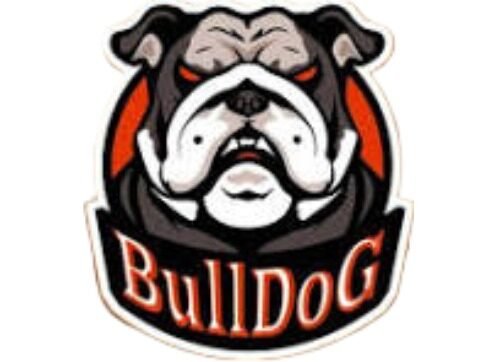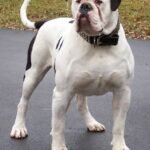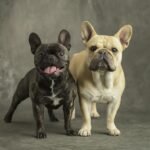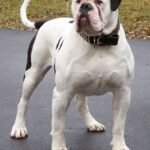The Victorian Bulldog is a big, strong dog with a large head and thick bones. It has a broad face and a short nose, but not so much that it has trouble breathing. Its hindquarters are a bit higher than its front, but it’s still well-balanced. Its cheeks are round and stick out a bit past its eyes. Its nose is big and wide, and it prefers to be black but it’s okay if it’s not. Its lips hang down over its jaw.

Its teeth are big and spaced out. Its eyes are set low and wide apart. Its ears can either be shaped like roses or buttons, and they don’t stand up straight. Its neck is strong and thick, with loose skin hanging down on each side. Its shoulders are broad and deep, and its chest is wide. Its ribs are rounded and its chest narrows a bit towards its back legs. Its front legs are strong and straight, not curved. Its back legs are powerful. Its feet are round and compact, and they can point straight ahead, downwards, or slightly sideways. Its coat is short and smooth, and it comes in different colors like stripes, solid white with patches, red, fawn, or light brown. It doesn’t come in black or black and tan.
History
The Victorian Bulldog became popular thanks to Ken Mollet, who wanted to make a healthier version of Bulldogs. In 1980, his brothers Derek Mollet and Graham Woods joined him. It took a while, but eventually, Ken worked on the breed alone. He used different types of dogs recognized by Kennel Clubs and healthy ones from respected breeders. Ken used Bullmastiffs, Staffords, and Dogue de Bordeaux to create the Victorian Bulldog. He studied old pictures to make sure it looked like Bulldogs from Victorian times. In 1988, Ken started the Victorian Bulldog Society. Today, there are many similar breeds, but the Victorian Bulldog still stands out.

Origins of the Victorian Bulldog
The Victorian Bulldog breed traces its ancestry to the bandogges, butcher’s dogges, and molossoids used in the cruel sport of bull-baiting in 18th and 19th century England. Bull-baiting involved dogs holding onto a bull’s nose until it became helpless, a practice believed to improve meat quality. With the sport’s ban in 1835, the breed faced extinction until enthusiasts intervened, crossbreeding to temper its appearance and temperament. Ken Mollet initiated the Victorian Bulldog breed in the 1980s, blending English Bulldogs with healthier breeds like the Bull Terrier, Bullmastiff, and Staffordshire Bull Terrier.
Breed Characteristics
Head: Moderately brachycephalic, square-shaped, with a wide top skull and a furrow from stop to occiput. Clean and wrinkle-free appearance preferred.
Eyes: Medium-sized, set wide apart, with preferred brown color and well-fitted eye rims. Entropion or ectropion are incorrect.
Ears: Small to medium, set back on the head, rose or tulip-shaped preferred. Erect, hound-like, or cropped ears are incorrect.
Muzzle: Broad, deep, full, and square, shorter than topskull but not flat. Prominent lower jaw slightly turned up, never protruding beyond lips.
Nose: Well-pigmented, black or self-colored, with well-opened nostrils.
Neck: Thick, muscular, slightly arched, tapering slightly toward head, with minimal dewlap.
Chest: Long, well-sprung, oval-shaped, never barrel-chested.
Body: Sturdy, powerful, solid, and agile, with equal width at forequarters and hindquarters.
Feet: Oval to round, compact, with well-arched toes and tough pads.
Tail: Set naturally, medium length, tapering towards tip, carried according to mood but never tucked or carried over back. Natural tail preferred, docking penalized
Height, Weight
| Characteristic | Dogs | Bitches |
| Height | 17-19 inches (43-48 cm) | 16-19 inches (41-48 cm) |
| Weight | 70-75 pounds (32-34 kg) | 55-65 pounds (25-30 kg) |
Personality of the Victorian Bulldog
The Victorian Bulldog is known for its loving nature. It’s very friendly and gets along well with both people and other animals. However, if not trained properly, it might not show its best behavior. Proper training is essential to bring out the best in this breed.
Compatibility with Children and Training
This dog breed is quite protective and makes a great companion for children. They’re easy to train, responding well to simple and clear instructions. With their high intelligence, they can handle more advanced training with engaging sessions.
Exercise Needs of the Victorian Bulldog
The Victorian Bulldog needs around 3 hours of activities every day. These activities can range from medium intensity to low-intensity exercises and mentally stimulating tasks. This helps them grow into responsible and well-behaved dogs. Exercise also keeps them balanced and contributes to their overall health and appearance.
Adaptability of the Victorian Bulldog
The Victorian Bulldog can easily adapt to moderate climates but struggles in extreme hot or cold weather. They’re comfortable in a small yard for movement, but a large apartment can also work well for them. While not overly energetic, they still need moderate exercise and mental stimulation every day to stay healthy and happy.
Coat Care for the Victorian Bulldog
The Victorian Bulldog sheds hair to a reasonable extent and needs brushing a few times a week. Washing them often can harm their coat by removing natural oils that keep it shiny and healthy. It’s important to maintain their natural shine!
About Our Victorian Bulldog Puppies
Our Victorian Bulldog puppies come from USDA licensed commercial breeders or hobby breeders with fewer than 5 breeding mothers. Less than 20% of all breeders in the country are USDA licensed commercial breeders. We avoid unregulated breeders, often called “Puppy Mills,” who don’t follow USDA regulations or have a license. We’re committed to providing Victorian Bulldog puppies that will become cherished members of your family. We only source puppies from the best breeders and stand behind every puppy we s

The Victorian Bulldog is a mix of beauty and strength, originally bred for bull-baiting in England. Ken Mollet brought the breed back in the 1980s, making it healthier and stronger. Nowadays, it’s loved for being affectionate and protective. With good training, it’s a great family pet, especially good with kids. Its unique looks and ability to adapt make it popular all over the world. The Victorian Bulldog is tough and charming, making it a beloved comp

- What is the average lifespan of a Victorian Bulldog?
- The average lifespan of a Victorian Bulldog ranges from 12 to 14 years, providing years of companionship and love.
- How much do Victorian Bulldogs weigh?
- Victorian Bulldogs typically weigh between 55 and 75 pounds, making them sturdy yet manageable companions for families and individuals alike.
- What breeds make a Victorian Bulldog?
- Victorian Bulldogs are a unique blend of English Bulldogs, Bull Terriers, Bull Mastiffs, and Staffordshire Bull Terriers. This combination was carefully curated to produce a healthier Bulldog breed, which has been widely successful since its inception in 2014.
- Can a Bulldog live 20 years?
- On average, Bulldogs have a lifespan of 8 to 10 years. However, with dedicated care and attention, some Bulldogs have exceeded this expectancy, showcasing the potential for longevity with proper nurturing.
- How old is a 13-year-old Bulldog in human years?
- According to the Dog Age Calculator, a 13-year-old Bulldog is roughly equivalent to 68 to 74 human years, depending on the dog’s size. This highlights the importance of cherishing every moment with our furry companions as they age.
- Do Victorian bulldogs have breathing problems?
- Unlike their ancestors, Victorian Bulldogs have been carefully bred to move powerfully, efficiently, and confidently. They exhibit unrestrained movement, free from the heavy breathing associated with some other Bulldog breeds. This emphasis on health and vitality sets Victorian Bulldogs apart, allowing them to enjoy an active lifestyle alongside their human companions.







